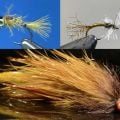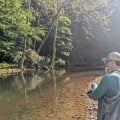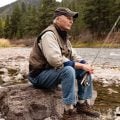The Trout Rodeo
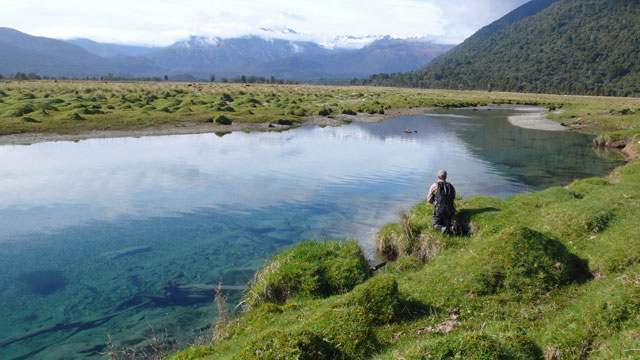 A few years in the planning, and a couple of false starts, but it was finally happening: we were going to fish in Haast, in New Zealand’s South Westland, during the prime time of the whitebaiting season. These last two words usually conjure up sentiments of large sea-run trout entering coastal estuaries to gorge on the little translucent squirts, but from past experiences we knew better than to base our expectations on such an elusive quarry. They come and go like silvery ghosts and often the closest you can get to one of them is when you hear a whitebaiter recounting: “there was a real big one here yesterday.”
A few years in the planning, and a couple of false starts, but it was finally happening: we were going to fish in Haast, in New Zealand’s South Westland, during the prime time of the whitebaiting season. These last two words usually conjure up sentiments of large sea-run trout entering coastal estuaries to gorge on the little translucent squirts, but from past experiences we knew better than to base our expectations on such an elusive quarry. They come and go like silvery ghosts and often the closest you can get to one of them is when you hear a whitebaiter recounting: “there was a real big one here yesterday.”
Once, I even managed to cast to such a leviathan, running after it along the gravel bank of the Arawhata River, repeatedly offering my best-money-can-buy silicon smelt to the fish that sloshed and zigzagged just below the sheen-metal surface, leaving a trail of takes that looked like multiple rises. But it didn’t take my fly and I did not get another chance. No, this time around we would not be chasing phantoms, though of course, we’d be ready if they materialised. On this trip we were happy to focus on the resident brown trout, big and resplendent, and presenting its own set of challenges, though thankfully rarity was not one of them.
We arrived the afternoon before the season’s opening. The day was perfect, the forecast even better. The three of us have all fished here before, though never together, not in such a concerted effort, not with a large window of clear weather open over the Coast. Craig Smith, who guides out of Lake Hawea, has so fallen in love with Haast he bought a house here, a classic West Coast crib, weather-beaten and rustic, with a shed full of nets, cray pots and ancient surf rods, all framed by a miniature Stonehenge of greenstone boulders, temporarily left behind by the previous owner.
The house, which was to be our base for the trip, is not quite the Ritz but what location! Walking distance to two major rivers and their combined estuary, surf thundering beyond the windswept bar shaped into a long sand dune, sunsets in the sea. That evening David Lloyd and I walked the bank of the estuary, rods in hand. The sea-runs were in there alright, vehemently chasing herrings which themselves were big enough to hunt whitebait. Neither of us had four or five-inch feathered lures, and the fish would not even look at anything small, so in the end we just watched and marvelled. The anticipation of what could be is often more titillating than achieving the object of desire itself.
The following day, as we stalked and fished the high banks of a local river, I was to learn one of the most important strategies I’ve ever come across in my life as a fly fisherman but to see its value you first need to understand something about the nature of Haast.
It is one of the most interesting places I’ve ever fished. People here still muster their cattle on horseback, and some riders drown in the process, and others still lose their 4WDs crossing rivers. Everything here is a couple of notches harder than it first appears. To wit, on one of our sighted fish, I faced a long and “draggy” cast and decided to wade in to better the odds. The river looked benign and only knee-deep, no worries there. Two steps in and the water was suddenly reaching the buckles of my chest waders. There was a “false bottom” to the river, a mixed concrete-like layer of silt and quicksand on top of gravel. My foundering spooked the fish. I didn’t wade much after that.
The inhabitants of Haast still cling to the old nickname Far Downers, as if to stress that in the search for their own promised land they went as far and as down as it was possible. I heard their story from Neroli Nolan, Craig’s neighbour who runs a lodge called Collyer House. One stormy evening during my previous visit, she stacked up the fire, poured out some good wine and took me on a time-travel tour to the days when Haast was considered the Wretched Coast, and its settlers, cheated and misled by a bureaucratic scandal, had to find their strength and forge their bush skills or die trying.
When the West Coast gold-fields had been worked out in the late 1860s, thousands of people found themselves with no work and the local government came up with an ingenious solution for them. It produced a prospectus about the promised land in the far south. Any man over 16 could take up a 10-acre section and a 50-acre block, and be granted their ownership. The land was fertile, covered with six feet of “black chocolate soil that’d produce almost anything”, and gold nuggets littered the beaches like sea shells. What’s more, a free passage to Haast was offered on the steamer Waipara to all those who dared to be rich. Desperate people flocked down to Haast, over 600 in total, and none of them knew that the free tickets on Waipara were a one-way deal.
On arrival, they found Haast more like a land of sweat, tears and despair. There was no chocolate-rich soil as promised, but a swamp humming with sandflies and mosquitoes, lashed by biblical rains, bordered by a sea and cut by rivers of uncommon severity. Disillusioned people trickled out of the district by any means possible. Some bought their way out, others simply walked off the land. By 1927 the total permanent population of Haast amounted to nine families and four single men. “The only people who stayed on,” Neroli said, “were those who couldn’t afford to leave.”
So you can see that Haast is a hard and harsh place and nothing here is easy, fly fishing included. This in itself is an attractive challenge but it also determines different rules of engagement, ones that I was about to learn.
A peculiarity of the Haast rivers is that they are absolutely choker-full of logs. The apocalyptic floods which come down from the Alps and periodically turn the rivers into something akin to horizontal waterfalls, bring down enormous amounts of timber debris. Logs piled up like pick-up sticks over deep pools and outside bends make an ideal habitat for large trout. And a hell for an angler trying to catch them.
It was my turn to cast when we came across this particular fish and, ever the optimist, I still had on a silicon smelt imitation tied to a length of solid tippet. As I put the fly down, it bounced off the surface slightly and the fish burst out and took it in the air.
“Yey!” Craig applauded, “I’ve never seen fish take a smelt for a dry.”
This, I knew, was the easy part. I looked around and saw trees everywhere. And I thought “here we go again, it’s like lassoing a wild horse in a forest.” The odds of not getting tangled were minimal.
Which was when Craig yelled out his little piece of advice though its significance was lost to me at first. “Rodeo him!”
What?
“Rodeo him! Keep him splashing on the surface so his fins are in the air. This way he can’t get any traction against the water. If he does …”
Oh, I knew all too well what happened when he did, when every square millimetre of his concertina-like fins found purchase against the water and its currents, when all his muscles, his entire being, were turbo-charged by the do-or-die boost of adrenalin.
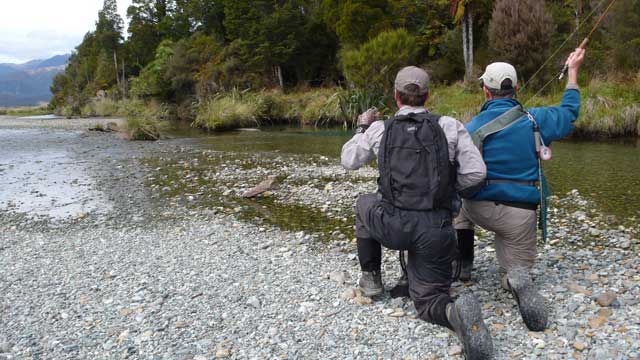 One summer, in the course of a day on a nearby river, so barricaded with fallen trees you’d think someone had introduced beavers here, and they nested and broke out into a plague, I hooked five fish all around the eight pound mark. The cicada takes were electrifying. The fish would often ram the fly first, stunning the artificial insect, then back off to watch for a reaction. At this point, with my whole world coming to a standstill of anticipation, I’d give the fly a slight twitch, as if the bumbling insect was about to get away, and the fish would strike again, this time with its mouth open.
One summer, in the course of a day on a nearby river, so barricaded with fallen trees you’d think someone had introduced beavers here, and they nested and broke out into a plague, I hooked five fish all around the eight pound mark. The cicada takes were electrifying. The fish would often ram the fly first, stunning the artificial insect, then back off to watch for a reaction. At this point, with my whole world coming to a standstill of anticipation, I’d give the fly a slight twitch, as if the bumbling insect was about to get away, and the fish would strike again, this time with its mouth open.
So far so easy. The flies, brown deer-hair cicadas, were half the size of my thumb and barbless, and the tippet, with nothing fancy required, was the 8lbs Maxima, as solid and dependable as trout tippets get. So what could possibly go wrong? Only one thing: the initial run seemed unstoppable and at the end of that each of those fish invariably found a tree to go under. The clever ones swam through entire root systems and weaved a couple of deft figure-of-eights around the tangle. The flyline would start to vibrate like a badly out-of-tune guitar string played by the current, and by this time, of course, the fish was long gone, having left me firmly fastened to a log jam. Only with one of those fish I had a glimmer of hope. As it took the fly I looked down and saw we had more than a 300 metre stretch of clear gravel, with not a snag in sight. “You’re mine,” I thought. Alas no. Once the fish put its muscles to it, in no time we covered those 300 metres, below which there was a mother of all log jams.
Each fish was a variation of the same scenario, so was the following day and the day after. Hooking those large fish – and by God there were plenty of them – was a child’s play but in three day’s fishing I did not land a single one.
Now Craig, who is a consummate backcountry adventurer, offered a practical solution to this quandary, not just theorising how it should be done but demonstrating it in action. You had to rodeo the fish, muscle it quickly the way a cowboy brings down and ropes a cattlebeast. Speed was of paramount importance if you were to take advantage of the trout’s shock and confusion at being hooked.
In a nutshell, you could not give these fish even an inch of slack. From the moment of hook-up you had to keep the fish flapping on the surface no matter what, while your gillie mate jumped into the water and netted the brute. This was easier said than done because the fish pulled so hard the rod tip was almost touching your reel hand. It was hard because it was counter-intuitive. By nature and from experience, you’d want to let the fish run, to tire it out, reel in just enough to keep a tight line and no more. But here you could not. These fish did not cut any slack.
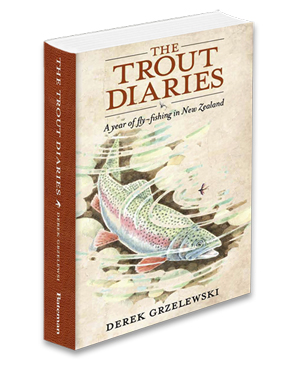 The rodeo approach meant that the entire combat was over in a flash which required a coordinated teamwork, and above all decisiveness and commitment on behalf of the netter. After a couple of bungled attempts we got the idea and the timing, and good that we did because it was obvious no other strategy would work here. Some of the fish we caught were literally living in deep-pool windows framed on all sides by logs and sunken trees. Even a moment’s hesitation, the tiniest bit of slack, was enough to let them find cover and snag the line.
The rodeo approach meant that the entire combat was over in a flash which required a coordinated teamwork, and above all decisiveness and commitment on behalf of the netter. After a couple of bungled attempts we got the idea and the timing, and good that we did because it was obvious no other strategy would work here. Some of the fish we caught were literally living in deep-pool windows framed on all sides by logs and sunken trees. Even a moment’s hesitation, the tiniest bit of slack, was enough to let them find cover and snag the line.
The following days, benefiting from Craig’s local knowledge, we explored a couple of little-known spring creeks and found plenty of fish. Almost without exception they favoured their log homes and without using the rodeo principle I doubt we would have landed any of them.
Walking back at the end of the day I thought how the fish here were as hardy and resilient creatures as any of the Coasters, and how anglers had to match and adapt to their ways. And I mused how, in an oblique sort of way the West Coast government prospectus was right. The Haast region was indeed a promised land, but only if you loved the high challenge of fly fishing for large and crafty trout.









